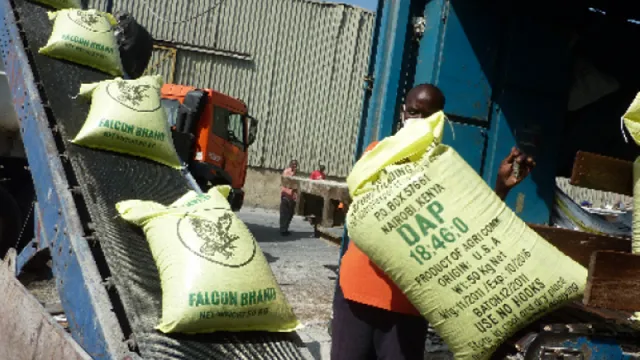State fertilizer programme on course but cursed dry weather

State fertilizer programme on course but cursed dry weather
I live in one of Nairobi city outskirts around Ruiru, proximal to a small river where the residents undertake farming on the riparian land. Napier grass, a highly preferred fodder by dairy farmers, is the most favored crop, especially on farmland bordering the Thika Superhighway perhaps due to its virtual insusceptibility to theft.
My small squat is at a tenement that is distal from the tarmac which means I have to walk to get to a matatu stop when coming into the city. Lucky for me, the antiquated colonial iron snake cuts through my neighbourhood making the Nairobi Commuter Train to Ruiru my preferred way of getting to town.
It also costs less, just Kes40 to squeeze into the boogies standing all the way to Nairobi Central Business District in record time, as opposed to those rowdy matatus where you pay twice as much and get stuck in traffic gridlock for hours.
The train's schedule can, however, be demanding and it waits for nobody, if you miss the hooting even by five minutes, just rain check for another day. So, when I slack off, I'm forced to trod the unmarked dirt path to catch a bus, although this seldom happens.
I am so inured to rail transport to the point that every time I get to use the all-weather feeder route leading to Thika Superhighway I find something new I have never seen before.
When partaking in such a trek recently, I was baffled to find a sizable plot previously harboring typical nappier grass repurposed for tomato and capsicum farming.
This was one courageous man tempting Ruiru residents with plump red tomatoes on the roadside when the price of the vegetable had gone up 8.9 percent to Kes97.4 a kilo with one tomato retailing at Kes10 a piece in my neighbourhood grocery stands.
One could tell the crops had been growing for weeks and were in the best shape possible. The superb health of the plants was nothing short of impressive especially in contrast with browning biomass on adjacent plots bearing the brunt of the proverbial January heat. Walking past the small scale horticultural venture had me thinking, "this one's got to be doing something right."
As fate would have it, my editor assigned me a story on how costly fertilizer was messing with Kenya’s agriculture. Some provisional data we had seen showed that fertilizer use had dropped 90 percent from 750,089 metric tonnes to 76,459 last year, a jaw dropping figure underscoring how precarious the situation is.
Kenya’s fertilizer imports were initially hit by the Covid-19 pandemic supply chain woes that pushed up prices nearly 30 percent. Then the Russia-Ukraine war, which is now marking a year since the first Russian bombs started raining on Kiev, hit tripling the cost of fertilizer as supply was disrupted and US-led sanctions choked Moscow.
My editor wanted to know how farmers were coping, whether they were cultivating less crop, or switching to organic fertilizer and how that was impacting yields, and of course, the price of tomato at my local mama mboga stand.
Interviewing a farmer, he told me, would impart an authentic and insightful point of view. Finding a respondent in my area would not be a problem and who better fit the bill than the enterprising horticulturalist busy by the river bank.
The task made for genuine pretext to venture out to the tomato farm and view the cultivation up-close something I have wanted to do since I saw the tomatoes. To say the truth, I was uncertain how to go about it. I'd done excursions before, but conducting interviews? I was green as a pool table.
Read also: Kenya’s drought appeal fund stuck at Sh600 million as famine ravages communities
But I had to power through the jitters having given a commitment to deliver my first featured story. It took a lot of psyching up and eventually, I purposely toured the site and found a farmhand irrigating capsicums, the green hanging heavy asking to be plucked, cleaned and sliced to spice up cooking and salads.
It can be hard to introduce yourself as a journalist from Maudhui House to people who only think about Nation Media Group, Citizen and Standard when they think about journalism. But this farmhand had probably never been visited by a journalist and he took me more seriously than I had anticipated.
After introduction, the labourer pointed me to the shack on the river bank where I found the farmer, a middle aged mukurino with a chequered purple-white shirt complete with a matching purple turban wrapped around in a neat headdress to symbolize the tenets of his faith as a peacemaker. I was glad this would make my interview a bit easier, less suspicious and more forthright.
Daudi Ndung'u Makumi does not look like a man who has smiled a lot in his life lately. He has become a man of very few words, a man who would rather talk to his plants than the people who eat them. And he made sure our sit-down was short-lived, but long enough for me to glean crucial information about farmers' woes in Kenya.
After the introduction, we sought to know his take on fertilizers but he sniffed us out and led us snout first into what farmers’ biggest concerns are; “Water scarcity is a bigger problem than unaffordable fertilizer. Water is the bigger problem due to insufficient rain in the past five seasons. Those waiting for rain are getting nothing because it is only getting drier," he said.
Expensive fertilizer has put a damper on Makumi’s farming business, pushing him to reducing the acreage under cultivation as well as applying smaller-than-ideal quantities to cope with the over Kes6,500 per 50-kilo bag of the farm input.
He is not alone, many farmers have cut the acreage under cultivation and scaled down on the volume of fertilizer used, sparking fear that this may worsen the already food insecure situation in Kenya.
Many farmers like Mr Makumi have resorted to supplementing commercial fertilizer with foliar manure to cut costs even as they wait for the subsidized fertilizer. But in the end, he says, production takes a hit because crops are just not getting the sufficient volume of nutrients.
"We have to mix solid fertilizer with foliar to cut costs, but crops are not growing the right way because we're putting in too little," he added.
Increasingly, farmers are finding it difficult to predict climate patterns in many rural areas practicing rain-fed agriculture that drives the biggest share of Kenya’s Gross Domestic Product (GDP).
According to the Treasury's 2023 Budget Policy Statement, agriculture is contributing on average 21.4 percent of the GDP directly, forming approximately 65 percent of Kenya’s total exports, and has the highest employment multiplier in the economy.
However, agricultural productivity in Kenya has been declining due to prolonged drought as a result of failed rain and high global fertilizer prices resulting in severe food shortage.
Farmers reliant on predicting weather patterns based on estimations handed down generations are having trouble getting the timing right for seasonal crops that are very sensitive to increasing vagrancies of weather. A choice that makes the difference between abundance and starvation.
Earlier, Mr Makumi was farming on a more than 10 acres but he has scaled down due to inadequate water supply. The prolonged dry conditions have also seen him abandon dairy farming due to biting scarcity of feeds.
The results, according to the World Bank, is that Kenya’s agriculture sector contracted by 1.5 percent in the first half of last year with its lackluster performance slowing GDP growth by 0.3 percent.
During the Monetary Policy Meeting at the end of January, Central Bank Governor Patrick Njoroge lamented that for two years, Kenya’s agriculture has declined with expectations it will dip 0.3 percent again this year.
“We all know this is because of the dry conditions we have been having. We expect a rebound if rainfall resumes normal conditions in 2023, normal, not floods, especially during the long rains,” Dr Njoroge said. The poor performance was mainly attributed to adverse weather conditions that characterized the first three quarters of 2022 with the decline reflecting in horticulture exports and milk taken in by processors.



